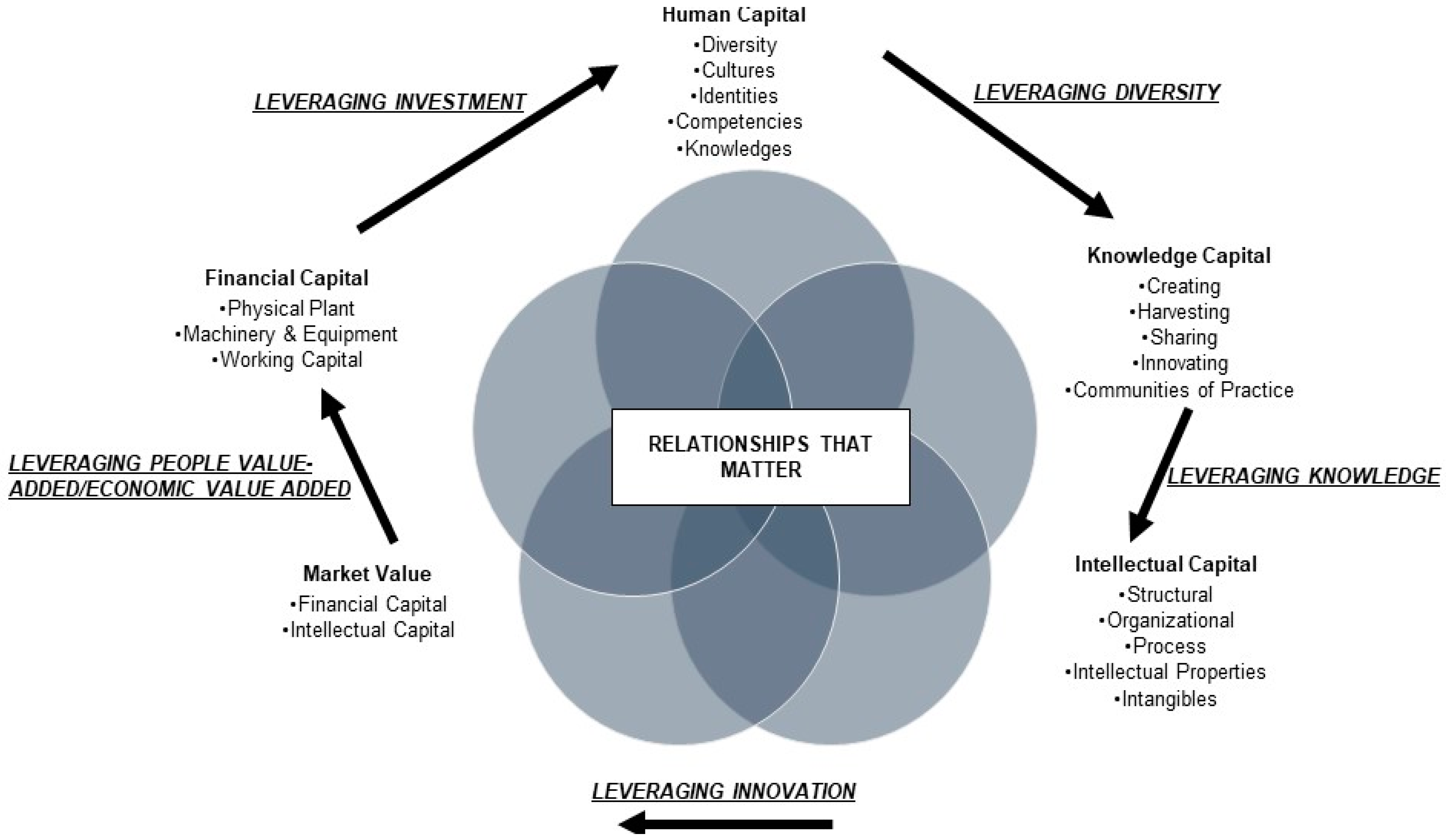Guidelines for Assessing and Enhancing the Organizational Vitality of Pharmacy Educational Programs: A Call to Action!
Abstract
:1. Introduction
2. Components of the Organizational Vitality Framework
2.1. Human Capital
Applying the “Human Capital” Element to Pharmacy School Operation
2.2. Knowledge Capital
Applying The Organizational Framework of “Knowledge Capital” to Pharmacy Schools
2.3. Intellectual Capital
Incorporating the “Intellectual Capital” Framework in Pharmacy Schools
2.4. Financial Capital
Applying the “Financial Capital” Element to Pharmacy School Organization
2.5. Market Value
Building The “Market Value” Component to Promote Pharmacy School Vitality
3. Conclusions
Author Contributions
Funding
Institutional Review Board Statement
Informed Consent Statement
Data Availability Statement
Conflicts of Interest
References
- Meggetto, E.; Kent, F.; Ward, B.; Keleher, H. Factors influencing implementation of organizational health literacy: A realist review. J. Health Organ. Manag. 2020, 34, 385–407. [Google Scholar] [CrossRef] [PubMed]
- Woodside, J.M. Organizational health management through metaphor: A mission-based approach. J. Health Organ. Manag. 2018, 32, 374–393. [Google Scholar] [CrossRef] [PubMed]
- Cameron, K.S.; Quinn, R.E. Diagnosing and Changing Organizational Culture Based on the Competing Values Framework, 3rd ed.; Jossey-Bass: Hoboken, NJ, USA, 2011; Available online: https://www.amazon.com/Leading-High-Energy-Culture-Atmosphere/dp/0071781269 (accessed on 29 August 2022).
- Casullo, D. Leading the High-Energy Culture: What the best CEOs Do to Create an Atmosphere Where Employees Flourish; McGraw-Hill Professional: New York, NY, USA, 2012. [Google Scholar]
- Nienaber, H.; Martins, N. Exploratory study: Determine which dimensions enhance the levels of employee engagement to improve organizational effectiveness. Total Qual. Manag. 2020, 32, 475–495. [Google Scholar] [CrossRef]
- Arslan, M. Organizational cynicism and employee performance: Moderating role of employee engagement. J. Glob. Responsib. 2018, 9, 415–431. [Google Scholar] [CrossRef]
- Hettinger, K.N.; Baker, C.M.; Brelage, M.E.; Smith, H.M.; Woodyard, J.L. The Impact Of COVID-19 On Pharmacy Student Stress During High-Stakes, Performance-Based Assessments in Skills-Based Courses. Am. J. Pharm. Educ. 2022, 86, 8874. [Google Scholar] [CrossRef]
- Lyons, K.M.; Christopoulos, A.; Brock, T.P. Sustainable Pharmacy Education in the Time of COVID-19. Am. J. Pharm. Educ. 2020, 84, ajpe8088. [Google Scholar] [CrossRef]
- Bronkhorst, B.; Vermeeren, B. Safety climate, worker health and organizational health performance. Int. J. Workplace Health Manag. 2016, 9, 270–289. [Google Scholar] [CrossRef]
- Coffey, D.S.; Education, C.O.S.W.; Elliot, K.; Goldblatt, E.; Grus, C.; Kishore, S.P.; Mancini, M.E.; Valachovic, R.; Walker, P.H.; Academy of Nutrition and Dietetics and Saint Louis University; et al. A Multifaceted Systems Approach to Addressing Stress Within Health Professions Education and Beyond. NAM Perspect. 2017, 7, 1–7. [Google Scholar] [CrossRef]
- Kawaguchi-Suzuki, M.; Nagai, N.; Akonoghrere, R.O.; Desborough, J.A. COVID-19 Pandemic Challenges and Lessons Learned by Pharmacy Educators Around the Globe. Am. J. Pharm. Educ. 2020, 84, ajpe8197. [Google Scholar] [CrossRef] [PubMed]
- Malcom, D.R. Loneliness as a Downstream Concern in a Pandemic (and Post-Pandemic) World. Am. J. Pharm. Educ. 2020, 85, 8456. [Google Scholar] [CrossRef]
- Medina, M.S.; Melchert, R.B.; Stowe, C.D. Fulfilling the Tripartite Mission During a Pandemic. Am. J. Pharm. Educ. 2020, 84, ajpe8156. [Google Scholar] [CrossRef]
- Park, H.C.; Hughes, J.A.; DeMark, R.L.; Diepenbrock, A.; McClendon, K.S. Using Team Innovation and Networking to Respond to Rapid Changes in the Academy. Am. J. Pharm. Educ. 2021, 86, 8661. [Google Scholar] [CrossRef]
- Sezen-Gültekin, G.; Argon, T. Examination of the relationship between organizational resilience and organizational sustainability at higher education institution. Int. J. Educ. 2020, 12, 329–343. [Google Scholar]
- Bishwas, S.K. LIFE: An integrated view of meta organizational process for vitality. J. Manag. Dev. 2016, 35, 747–764. [Google Scholar] [CrossRef]
- Vicenzi, R.; Adkins, G. A Tool for Assessing Organizational Vitality in an Era of Complexity. Technol. Forecast. Soc. Chang. 2000, 64, 101–113. [Google Scholar] [CrossRef]
- Chapman, G.D.; White, P.E. The 5 Languages of Appreciation in the Workplace: Empowering Organizations by Encouraging People; Northfield Publishing: Chicago, IL, USA, 2011. [Google Scholar]
- Rath, T. StrengthsFinder 2.0; Gallup Press: New York, NY, USA, 2007. [Google Scholar]
- Kirkpatrick, D.L. Evaluation of training. In Training and Development Handbook; Craig, R.L., Bittel, L.R., Eds.; McGraw-Hill: New York, NY, USA, 1967; pp. 87–112. [Google Scholar]

| Human Capital | Do Academic Leaders…?
|
| Knowledge Capital |
|
| Information Capital |
|
| Financial Capital |
|
Publisher’s Note: MDPI stays neutral with regard to jurisdictional claims in published maps and institutional affiliations. |
© 2022 by the authors. Licensee MDPI, Basel, Switzerland. This article is an open access article distributed under the terms and conditions of the Creative Commons Attribution (CC BY) license (https://creativecommons.org/licenses/by/4.0/).
Share and Cite
Malhotra, A.; Hughes, J.; Fuentes, D.G. Guidelines for Assessing and Enhancing the Organizational Vitality of Pharmacy Educational Programs: A Call to Action! Pharmacy 2022, 10, 128. https://doi.org/10.3390/pharmacy10050128
Malhotra A, Hughes J, Fuentes DG. Guidelines for Assessing and Enhancing the Organizational Vitality of Pharmacy Educational Programs: A Call to Action! Pharmacy. 2022; 10(5):128. https://doi.org/10.3390/pharmacy10050128
Chicago/Turabian StyleMalhotra, Ashim, Jeremy Hughes, and David G. Fuentes. 2022. "Guidelines for Assessing and Enhancing the Organizational Vitality of Pharmacy Educational Programs: A Call to Action!" Pharmacy 10, no. 5: 128. https://doi.org/10.3390/pharmacy10050128
APA StyleMalhotra, A., Hughes, J., & Fuentes, D. G. (2022). Guidelines for Assessing and Enhancing the Organizational Vitality of Pharmacy Educational Programs: A Call to Action! Pharmacy, 10(5), 128. https://doi.org/10.3390/pharmacy10050128







